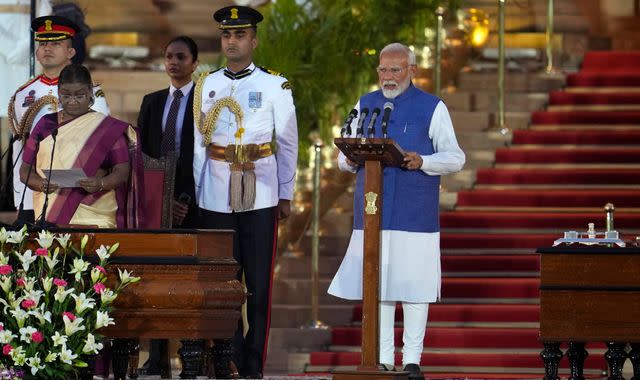Even as India's Narendra Modi is sworn in as PM for third time, he is diminished

Narendra Modi has been sworn in as prime minister for a third consecutive term by India's President Droupadi Murmu at a ceremony in New Delhi.
The 73-year-old is only the second prime minister, after Jawaharlal Nehru, to win three terms since the country gained independence in 1947.
Heads of almost all of the South Asian nation's neighbours were present at the ceremony - but the absence of Pakistan's leader was conspicuous, with relations between the two nuclear-armed neighbours being at their lowest over the past few years.
A multi-layered security blanket covered the venue with thousands of police and paramilitaries deployed in the nation's capital. A no-fly zone over the region has been enforced as well as a ban on paragliders, hang gliders, UAVs, microlight aircraft, and hot air balloons.
Unlike the first two terms, Mr Modi's Bharatiya Janata Party (BJP) failed to win a majority and is now entirely reliant on smaller regional parties to form and stabilise his rule for the next five years.
Its been a bruising victory for Mr Modi, who won a landslide victory in 2014. Since then he has dominated the political landscape of the country.
Read more:
Narendra Modi: A history-making leader with god-like status
In 2019, Mr Modi achieved an increased mandate of 303 seats of the 543 seats in parliament. The overwhelming majority provided him a carte blanche to govern without being dependent on coalition partners. A few of his allies withdrew support but this did not affect the stability of his government.
This time around it's different. With 240 seats, his party has fallen short by 32 seats and has to rely entirely on smaller regional parties.
The BJP-led National Democratic Alliance (NDA), along with many other smaller parties, will help Mr Modi to the crucial halfway mark of 272 seats in parliament.
In the past, governments have fallen by just one vote and Mr Modi will be mindful of the potential of his alliance partners to do him damage.
The Telugu Desam Party (TDP) from Andhra Pradesh with 16 MPs and the Janata Dal United (JDU) party from Bihar with 12 MPs hold the key to the stability of Mr Modi's government.
These partners, however small, will extract their own pound of flesh for their support.
Once seen as an invincible strong man heading a Hindu-dominant BJP relying on the religious majority, Mr Modi has now been punished by the Indian voter - especially in rural areas.
This can be seen in the northern state of Uttar Pradesh (UP), which has 80 seats and where the BJP won just 33, down 29 from the previous election.
Mr Modi's right-wing government relies heavily on wooing the Hindu majority, some 80% of the population.
With an eye on the elections, Mr Modi consecrated the Lord Ram Temple in Ayodhya earlier this year. Yet the city, which falls under the constituency of Faizabad, elected a non-BJP candidate.
Read more:
India election: PM Narendra Modi's coalition wins majority
Mr Modi himself fought his third election from the holy city of Varanasi and won by a margin of just 152,513 votes, significantly lower than his 2019 winning margin of 480,000 votes.
In his party he is ranked 116 out of the 240 winning MPs by vote margin, one of the lowest ever by a sitting prime minister.
The results are a blow to Mr Modi and the carefully crafted image he portrays.
During the election, he resorted to strident anti-Muslim rhetoric. His campaign was conspicuously devoid of the achievements of the last 10 years of government.
That, while the Congress-led opposition campaigned on issues of high unemployment, inflation, cost of living crisis, farmers' woes and rural distress.
India may have overtaken Britain as the fifth-largest economy in the world during Mr Modi's term - but its GDP per capita remains dismal, with India ranking 136th globally.
Unemployment is a persistent problem and thousands of young men risk their lives to seek a better future outside India.
Inequality is at a historic high, even more stark than under colonial Britain.
According to a report by the Paris-based World Inequalities Lab, the top 1% of India's population controls 40% of the nation's wealth.
India ranks 111th out of the 125 nations in the Global Hunger Index (2023) report. The government, however, has rejected the report's findings.
Last year, Mr Modi announced the extension of a free food ration scheme to 800 million Indians for the next five years.
In his third term, Mr Modi is diminished and his right-wing bombast is no longer attractive to the ordinary person, especially the younger generation.
Mr Modi now faces an emboldened opposition whose economic and social programmes are attractive.
He will need to shun the divisive narrative that no longer washes with the public and maintain and protect the liberal and secular values on which the country was created.

